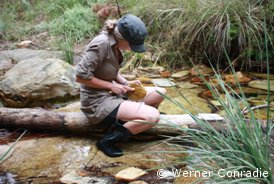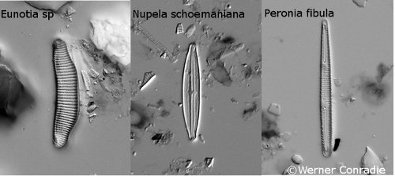We have recently brought in a new monitoring tool to help devise conservation management actions for Hewitt’s Ghost Frog: a full spectrum diatom analysis of the Geelhoutboom River. But firstly, what is a diatom? Diatoms are microscopic, one-celled algae that can be found in colonies or as single cells and are usually abundant in aquatic systems. A diatom forms a cell wall made of silica and we identify different species by the unique cell wall patterns, cell size, and shape.
We propose a study of diatoms can benefit tadpole conservation. The presence of heavy metals and toxins can interrupt diatom cell wall formation, this along with the fact that diatoms rapidly respond to environmental change due to species specific needs (pH, nutrients, etc.) make them excellent bio-indicators. Furthermore, because diatoms are primary producers at the foot of the aquatic food-web, they have a direct relationship to environmental stressors making them even better monitors. Conservationists seek more environmental information in order to make measured decisions, regarding the future wellbeing of the endangered Hewitt’s Ghost Frog our current work could become a useful tool for them.
For this project, Vidette Botha, a post-grad student, set out to assess the diatom composition of the Geelhoutboom River and to compare differences in species abundance and diversity during seasonal cycles.
Vidette first had to establish if ghost frog tadpoles do indeed feed on diatoms. For this she had to analyze the stomach contents of tadpoles. The result indicated that diatoms make out a large part of their diet. She then compared this against the diatoms available in the rivers. This study is still underway but has already produced some interesting findings. For example, we have found that the dominant diatom species found in the Geelhoutboom River include many Eunotia species, which are indicatory of acidic habitats that are electrolyte-poor. Another species equally dominant to all the Eunotia species is Nupela schoemaniana which is associated with clean water, and good quality habitats.
However, signs of cell wall defamation slightly above environmental norm did occur. This might be due to the presence of toxins in the water and requires further investigation. The forestry industry makes use of a toxin called Kilomax which is labeled ‘Frog friendly’, however it is unknown if this toxin is harmful to other morphological stages or diatoms. Another significant find is the species Peronia fibula which was present in both Geelhoutboom River sites and has been found less than 5 times in South Africa.
We hope this study will continue to provide interesting findings and provide us with a new tool in the conservation planning for Hewitt’s Ghost Frog.


